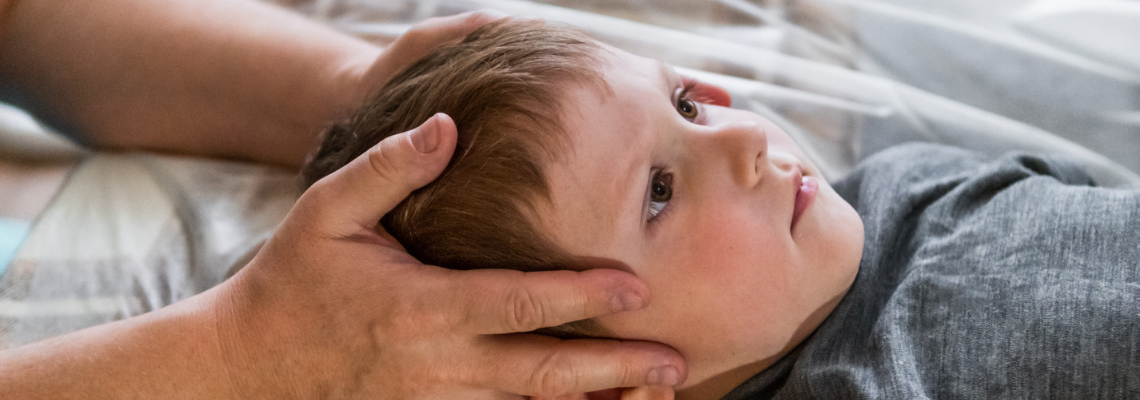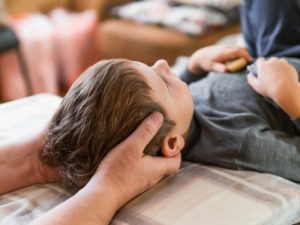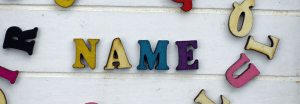
In a complicated delivery, babies may face several stressful challenges on their way into the world. Craniosacral therapy for a baby may sound strange, but it is very beneficial to newborns. Studies have revealed that most newborn babies may have some degree of birth stress later in life. The skull is wonderfully designed to adjust and move as the baby goes through the birth canal.
A newborn’s head is strong enough and flexible in finding its way out under pressure. However, when the cranial bones are compressed or twisted, problems may occur because they will remain out of shape. Problems include:
- Traumatic birth
- Vacuum extraction
- Forceps delivery
A successful transition from the womb to the universe could be a challenge. The baby may be fussy, have a flathead or experience gastric reflux, torticollis, constipation and tongue tie. Craniosacral therapy is effective in managing teething, colic, feeding and nursing issues.
The treatment is beneficial to the babies and the new parents as they navigate through their new roles. As the baby gets more comfortable in the new environment, bonding is enhanced.
About Craniosacral Therapy
The therapy entails light touches to the head bones and massage using a specialized, hands-on, therapeutic technique. It assists the baby to recover from trauma, boosts immunity, promotes growth and minimizes pain. The therapy aims at reducing the tension and pressure in the baby’s central nervous system.
There is a link between the cerebrospinal fluid in the brain and the sacrum. The two areas control numerous body actions. By applying a light touch or massage, a specialist in craniosacral therapy (CST) minimizes blockage in these areas and boosts the body’s ability to heal.
 Craniosacral therapy effectively relieves ear infections, enhances coordination and manages jaw issues, hyperactivity, eye problems, headaches and migraine. CST is believed to be an advancement on cranial osteopathy developed in the 1920s by William Sutherland, D.O.
Craniosacral therapy effectively relieves ear infections, enhances coordination and manages jaw issues, hyperactivity, eye problems, headaches and migraine. CST is believed to be an advancement on cranial osteopathy developed in the 1920s by William Sutherland, D.O.
When your baby feels relaxed, loved and safe, he or she can communicate the regions of tension. Upon release and balancing of stress, the baby is likely to fully relax. A sensitive and compassionate therapist will find the areas that require adjustment. The gentle touch unwinds misalignment and compression on the baby, facilitating stress release.
Besides feeling relaxation, the body will also soften. In the absence of tension and pressure, the body and the brain reacquire the necessary space for proper functioning and natural growth. The baby’s wellbeing and health will significantly improve.
Benefits of Craniosacral Therapy
Studies indicate that newborns benefit greatly from CST within the first two weeks after birth. It is vital in preventing complications in both childhood and adulthood. Some common complications that it’s effective against are spinal disorders and developmental problems. For a good start in life, it is advisable to take your baby to a CST specialist.
About three sessions have been proven to be effective. However, improvement will be evident after the first session. Craniosacral therapy relieves compression in the back, neck and head. Besides soothing pain, it relives both physical and emotional tension and stress.
Therapists also claim that it restores cranial mobility and minimizes nerve, neck and head restriction. For premature babies and after a challenging delivery, several treatments may be necessary. In such a scenario, you may only notice significant improvement after several treatments.
Side Effects
Generally, the therapy is safe because of the appropriate pressure applied by the practitioner. For infants with brain damage, studies suggest that CST may exacerbate the condition. However, more investigations are still required to confirm the claim. Most of the side effects associated with the therapy are mild and disappear within 24 hours.
Craniosacral therapy is prohibited in case the baby has fractures on the skull and intracranial bleeding. It is also inappropriate in babies with aneurysms and severe bleeding disorders. CST is also associated with nausea, diarrhea, lightheadedness and dizziness.
It’s never too late to try the services of CST specialists since children and adults still benefit from its healing and relaxation properties. Craniosacral therapy is gaining popularity because it is associated with fewer side effects compared to prescription medications.


